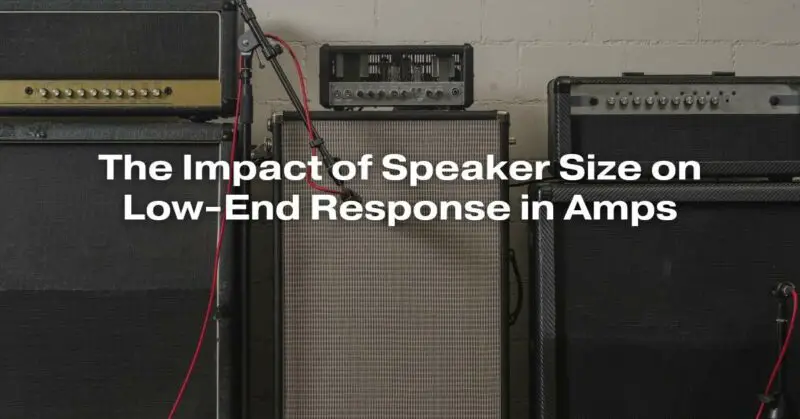When it comes to electric guitar amplifiers, one of the most crucial factors influencing the overall sound and performance is the choice of speaker size. The low-end response, or the ability of an amp to reproduce deep bass frequencies, is significantly affected by the size of the speaker. In this article, we’ll explore the relationship between speaker size and low-end response in amps, examining how different speaker sizes can impact the tone, versatility, and application of an amplifier.
Understanding the Basics of Speaker Size
Before diving into the specifics of how speaker size influences low-end response, it’s essential to understand some basics about speakers. In the context of guitar amplifiers, speakers come in various sizes, commonly ranging from 8 inches to 15 inches in diameter, with 10-inch and 12-inch speakers being the most popular choices.
Speaker size primarily refers to the diameter of the speaker cone, measured in inches. The size of the speaker cone directly affects how it reproduces different frequencies, with larger speakers typically being more capable of producing lower frequencies.
Low-End Response and Speaker Size
Low-end response, often referred to as “bass response” or “bottom end,” is a critical aspect of a guitar amplifier’s tone. It encompasses the ability of the amplifier and speaker combination to reproduce deep, resonant bass frequencies. The relationship between speaker size and low-end response is relatively straightforward:
- Larger Speakers Produce Deeper Bass: Larger speakers, such as 12-inch or 15-inch models, have more surface area to move air. This allows them to generate more significant low-frequency vibrations, resulting in deeper and more pronounced bass response. Musicians who play styles of music that rely heavily on deep bass, like blues, jazz, or heavy metal, often prefer amplifiers with larger speakers.
- Smaller Speakers Focus on Midrange: Smaller speakers, like 8-inch and 10-inch models, are inherently limited in their ability to reproduce deep bass frequencies. They are more focused on midrange frequencies and can provide a tighter and punchier sound. Amplifiers with smaller speakers are often favored for genres that require precise articulation and less emphasis on the low end, such as rock and country.
- Speaker Configurations Matter: In addition to speaker size, the configuration of the speakers in an amplifier cabinet plays a crucial role in low-end response. Multiple speakers in a cabinet can work together to produce a fuller sound, even with smaller speakers. Common configurations include single, 2×12, and 4×12 setups, each offering a unique balance between low-end response and projection.
Practical Considerations
The choice of speaker size should align with your musical preferences, playing style, and the context in which you plan to use your amplifier. Here are some practical considerations to keep in mind:
- Genre and Playing Style: Consider the musical genres you primarily play and the tonal characteristics you desire. If you’re a metal guitarist who needs thunderous low-end power, a 4×12 cabinet with 12-inch speakers may be ideal. Conversely, a jazz guitarist might prefer a smaller combo amp with a 10-inch speaker for its focused midrange.
- Portability: Smaller speakers and cabinets are generally more portable and lightweight. If you need an amplifier for gigging or traveling, a compact amp with an 8-inch or 10-inch speaker might be a more practical choice.
- Versatility: Some musicians require versatility in their amplifiers. In such cases, amplifiers with multiple speaker outputs can accommodate various speaker sizes. This allows you to switch between speakers to suit different playing situations.
- Volume Considerations: The size of the venue you typically perform in can also influence your choice. Larger venues may require more substantial low-end response for the sound to carry effectively.
- Tone Shaping: Keep in mind that while speaker size has a significant impact on low-end response, it’s not the only factor. Amp design, speaker type, and the presence of tone-shaping controls on the amplifier itself all contribute to the final tone.
Conclusion
In the world of electric guitar amplifiers, the impact of speaker size on low-end response is a fundamental consideration. Larger speakers are capable of producing deeper bass frequencies, making them well-suited for styles of music that require a robust low-end presence. Smaller speakers, on the other hand, offer tighter midrange-focused tones, ideal for genres where precision and articulation are essential.
Ultimately, the choice of speaker size should align with your musical goals and playing style. Whether you opt for a massive 4×12 cabinet or a compact 1×10 combo amp, understanding the relationship between speaker size and low-end response empowers you to make an informed decision and shape your amplifier’s tone to suit your artistic vision. Remember that there’s no one-size-fits-all answer, and experimenting with different setups can lead to exciting new sonic possibilities in your guitar playing journey.


